Good PMO reports will allow you to discern the current state in the project environment quickly. Decision-makers should see at first sight what needs to be decided. This article deals with the optimization of PMO reports in the context of modern, IT-supported reporting.
We will go into detail on the following topics:
- Reports geared to stakeholders
- Selection criteria for portfolio meetings
- Necessary information to include in reports
- Quality assurance
- etc.
What is more, you will receive a checklist and examples of possible contents for individual reports which are useful for you as the PMO.
- Requirements for PMO Reports in Project and Portfolio Management
- Project Management Reports for Different Stakeholders at the Company
- Reporting Periods in Portfolio and Project Management
- What Reports Make Sense?
- Selection in the Multi-Project Environment
- Possible Contents for Reports of Individual Projects
- Efficient Data Collection as the Basis for PMO Reports
- Ensuring Data Quality
- Determining Factors for Modern Reporting
- Checklist: The 10 Most Important Questions on Reporting
- Conclusion – PMO Reports for Project and Portfolio Management
Let us begin with who is responsible for the contents of reports.
Special Download: How to setup a PMO in 4 simple steps (PDF file)
Please fill in the form.
* Required Fields | Data Protection
Why Project Reports Should Be at the Beginning
The Project Management Office (PMO) is responsible for the reports in project and portfolio management (PPM).
This task encompasses not only the structure and the selection of the presented information. Among the PMO responsibilities there is another important task that is not always easy. It has to ensure the quality of the reports with regard to currency and correctness.
The problem: when introducing project and portfolio management solutions (PPM) the reporting topic is often considered too late. Does that sound familiar?
It would be ideal if the PMO put reports at the very beginning. In such a case, the PPM system would be planned around the reports and their users.
For reports make you realize what is happening and what needs to be decided. They help you focus on the essentials and get the most out of your PPM system.
But this is only half the battle. To enable you to react to the developments in the project environment really quickly, your reports need to be up to date and flexible, too.
The subsequent chapter will introduce you to the requirements for reports in project and portfolio management.
Special Download: 10 Vital PMO Success Factors (PDF file)
Please fill in the form.
* Required Fields | Data Protection
Requirements for PMO Reports in Project and Portfolio Management
These days, IT allows us to present reports quickly on the screen, both in color and in the desired level of detail. When it comes to what information e.g. a PMO envisions for the company, classic fixed notions for the preparation come into play:
Classic requirements for reports in project management
|
|
|
|
|
|
|
|
|
|
|
|
|
|
|
|
Actual requirements for reports in project management
The actual reporting requirements are more realistic. They can be summed up in one sentence:
So you should always ask yourself this question when setting up a reporting system:
- What do I aim to plan and control?
- What information will I require for this?
- Which level of detail makes sense?
- What do I want to achieve with which report?
- Who will be working with the reports afterwards?
- Will the recipients of the reports be able to grasp the contents?
Tip: Honest answers to the questions are an important prerequisite for your future reports. Their generation needs to be efficient, without unnecessary data baggage. A prior stakeholder analysis is advisable at any rate.
PMO Reports for Different Stakeholders at the Company
As a rule, every company has several different levels requiring different reports. The higher up in the hierarchy, the more condensed the information needs to be.
Still, a drill-down to the details needs to be possible on demand. This makes it possible to comprehend the consolidated report information in the case of inquiries
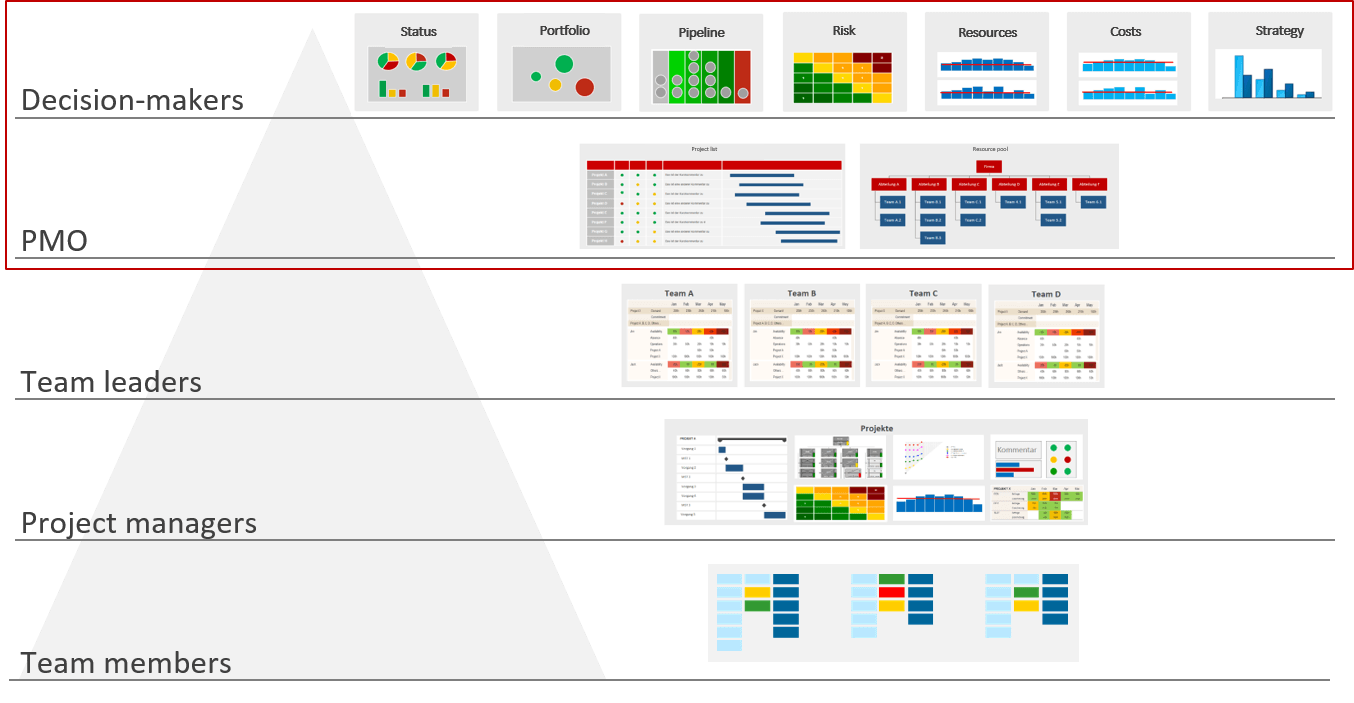
- Decision-makers
- Top management requires consolidated information for management control on a regular basis. For instance, they consider the adherence to the strategic focus, risks or investment risks.
- PMO
- A PMO often prepares the reports on projects and resources at portfolio level for top management. It requires a project list with the status to be able to check with project managers when this seems necessary. Any escalations identified are reported to the top for decision-making.
- Team leaders
- Team leaders are responsible for their resources. For this, they require the corresponding overviews of their teams’ workload and availability. In addition, they need to be able to make reliable resource commitments for the projects to the project managers.
- Project managers
- When planning individual projects, the project manager uses e.g. the status report, the work breakdown structure, the milestone overview or possibly a Milestone Trend Analysis.
- Project team members
- Project team members want to see their work packages. What is more, they are interested in who else is working on the project and in time recording. This is less about classic reports but more about available information.
Note: To demonstrate the benefits your PMO provides you should define a set of key performance indicators and align them with your stakeholders. The right PMO KPIs will assist you in this endeavor.
Reporting Periods in Portfolio and Project Management
Reports are the basis for coordination meetings. They help to understand what is currently happening at the company. And where decisions are at present necessary.
The higher up in the hierarchy, the more condensed is the information and the less frequent the reporting.
The figure below clarifies how the reporting periods at the individual levels result from the individual meetings. Relative to the hierarchical level, the information becomes increasingly condensed. At the same time, the frequency of reporting decreases accordingly.
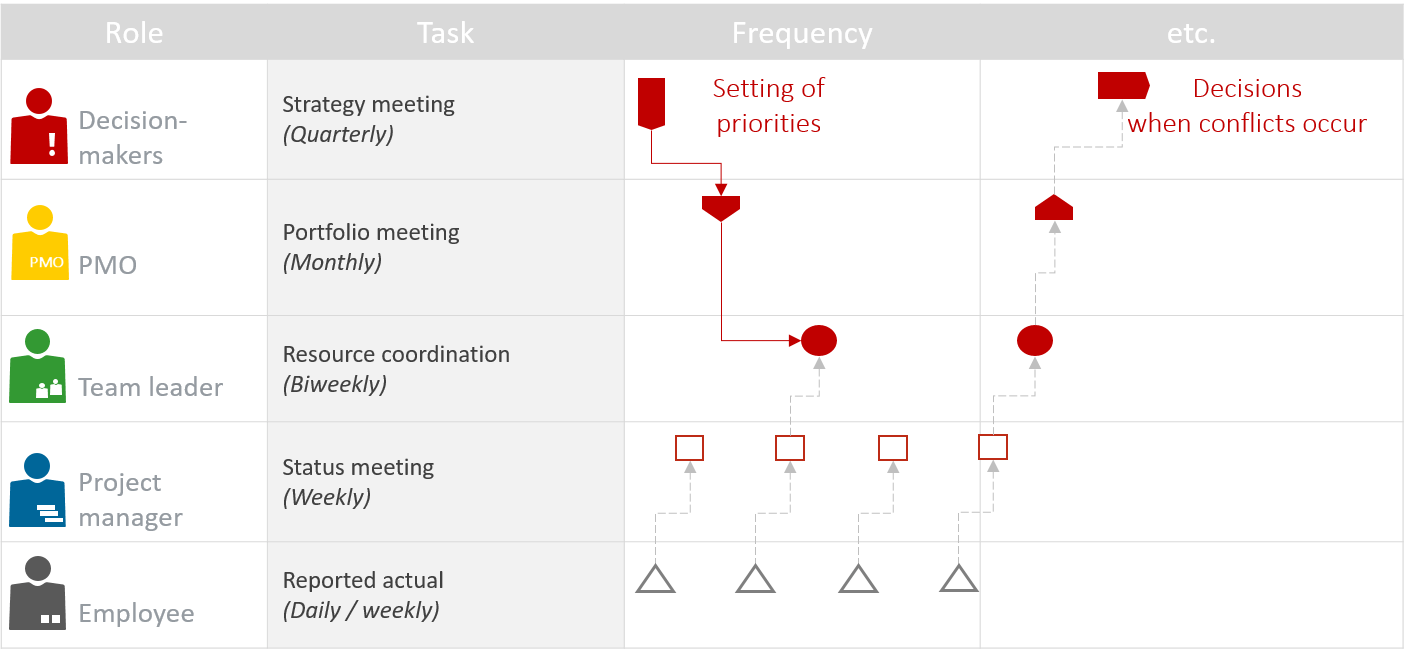
What decisions may or must be made where? Subject to this, you need to ensure that the required information is available in the form of meaningful reports.
In the process, you also need to decide which element is useful for which report. This should not be detrimental to the clarity of the overview or the intelligibility.
What Reports Make Sense?
The question of which reports are useful always requires a very individual answer. The figure below provides an overview. It shows which reports make sense across the hierarchies. Naturally, this depends to a large extent on your company’s:
- size
- processes
- industry
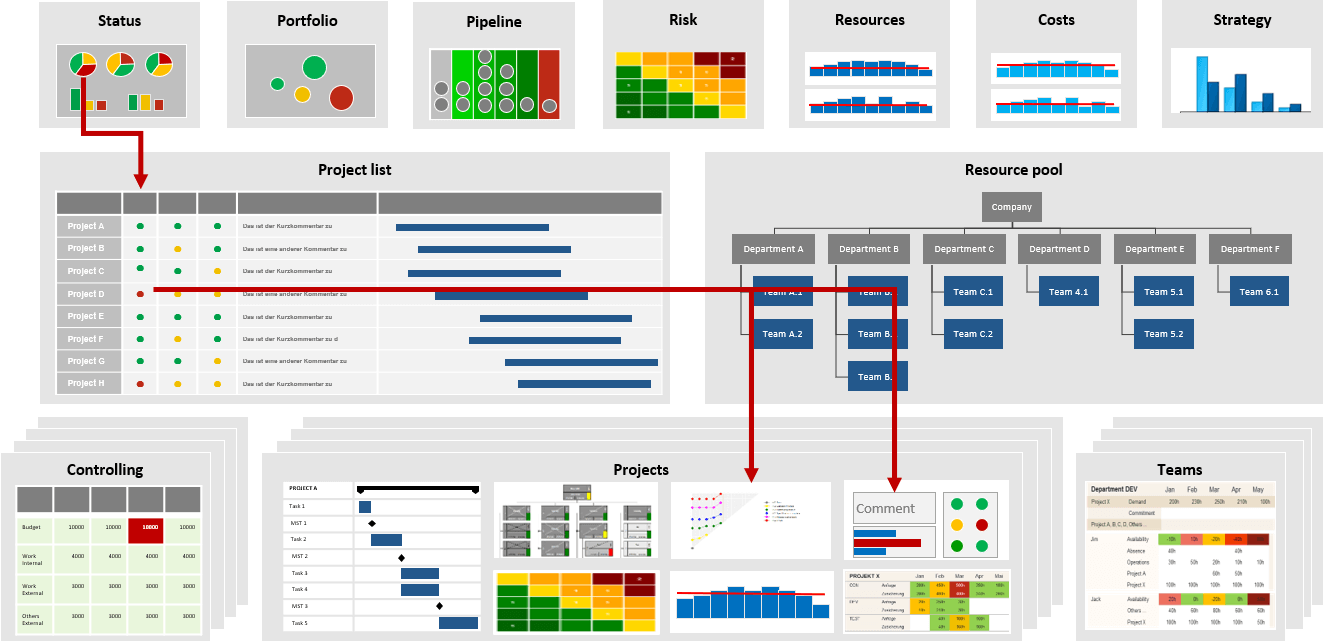
Unfortunately, there is no ONE project management report that is right for all. While reports tend to look similar, they have to be adapted to the respective processes and needs of the company. This always depends on the intended use and the recipients.
It might help you to work out the reporting requirements and their possible implementation in a workshop with important stakeholders and the support of an experienced PMO consultant.
Below, you will find an overview of possible reports from the PMO environment.
Example: Portfolio Dashboard
Example: Project Pipeline Report
Example: Resources & roadmap report
Example: Simple Project Status Report
Example: Team Planning and Commitment in Response to Project Request
Example: Project overview as an interactive website
Example: Current Status of the Portfolio (Evolution-Over-Time Perspective)
Example: Current Developments
Example: Review of the Portfolio
Example: Earned Value Indices
Find out more in our article on the contents and process of the Project Status Report.
Tip: As the PMO, it is wise to keep an eye on the number of reports. Over time, this is very likely increase, as new ones tend to be added continually. A periodic consolidation can ensure that your reporting retains its efficiency as a whole.
Selection in the Multi-Project Environment
Often, the PMO is responsible for the preparation of the portfolio meeting. In a multi-project environment, the selection is the challenge. From the project portfolio, which can be very substantial, you need to select certain projects. These need to be the ones which can be covered during the portfolio meeting.
This ensures that the need for decisions is identified early enabling you to make the necessary decisions, too.
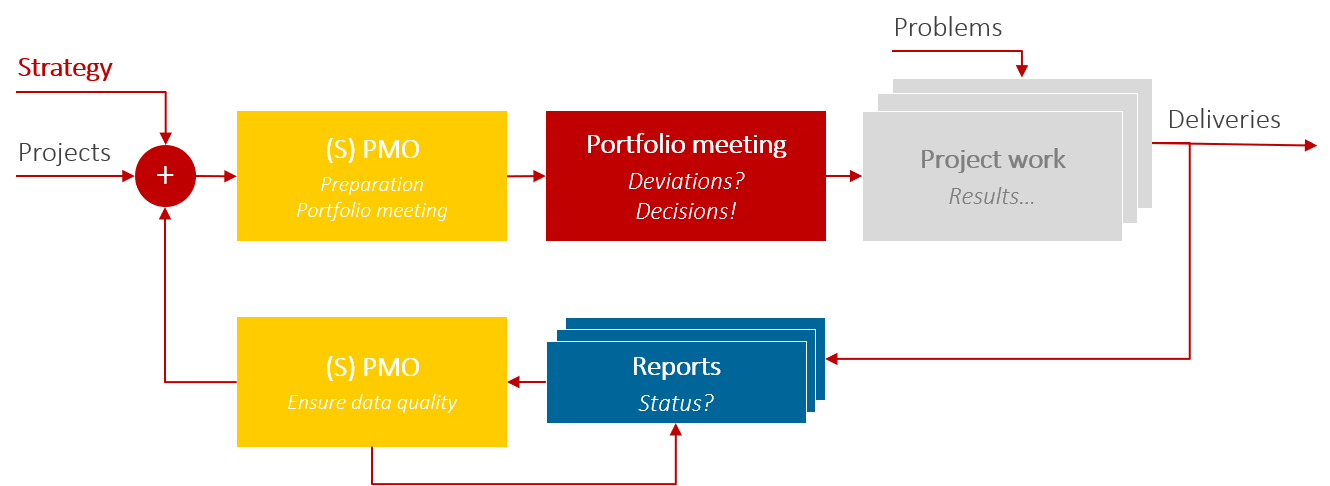
The following list provides criteria by which you in the PMO could make a project selection for review:
- Declared need for decisions (manually set indicator)
- All projects with status RED (Overall, resources, schedule …) + 3 YELLOW + 3 GREEN (as samples to check for data quality, more detail further below)
- All project in the top 3 risk categories
- Top 10 in terms of variance (cost, schedule, work)
- Top 10 strategic contribution / priority
- All projects above a threshold value (order / investment volume, contractual penalty …)
- Problem areas (technology, regions, project manager, product categories …)
Subscribe to the TPG Blog Newsletter now and never miss another blog post.
Possible Contents for Reports of Individual Projects
What information should the reports of individual projects contain? Possible information on results, deliveries and states could be:
- Achievement of milestones (standard milestones)
- Completion of phases (phase model)
- Acceptance of deliveries planned / effected (payment milestones)
- Completion of work packages / deliveries (definition of “done”)
- Completion of tasks (not started / in progress / completed)
- List of open issues (open / started / completed)
- Earned Value Analysis (Baseline and %Physical Complete)
- %Complete (no appropriate statement below 100% … 99% syndrome, i.e. the danger of the permanent 99% value)
For quality assurance, the report should include plausibility checks, such as:
- Comparison between remaining effort and reported stage of completion
- Relation between %Cost / %Work / %Time / %Physical Complete (relation of the values to each other)
To determine the plan-actual variance we recommend the following information:
- Deliveries: Plan / actual of quality, scheduling, effort, cost
- Work outstanding: Clarity of proof of concept, work / budget, cost / budget, schedule / plan
- Resources: assign, shift, withdraw
When it comes to decisions on the next steps, the following information is helpful:
- Order / follow-up: entered or not (continue regardless?)
- Budget: available or too low (continue only after increase?)
- Resources: committed or too few (escalation or postponement?)
- Risk situation: manageable or unfavorable (any known alternatives?)
- Chosen option: Method A or B (documentation of the decision including reasons)
Once the PMO has prepared the meeting, it is important to ensure one thing. During the meeting, the necessary data to provide answers to the decision-makers’ questions need to be available – preferably at the push of a button.
Tip: The report after a meeting is also an important medium. Communicate the results of the meeting to all parties concerned. This is the only way to make them adjust their further actions to the results of the meeting.
Efficient Data Collection as the Basis for PMO Reports
At many companies, collecting the data for the reports takes longer than the actual analysis and preparation.
This can be handled much more efficiently once you do not have to collect various Excel files and consolidate them.
It is best to work with a suitable database from the start. This database should allow integration with other systems and a central data evaluation for reports. This leaves more time for the analysis of the reports. This analysis in turn enables well-founded and fast decisions based on up-to-date data.
Note: If you are looking for external support in setting up a PMO, you can find PMO consulting here. A method for PMO implementation helps to reach Level 2 of the the Gartner PPM Maturity Model within a maximum of 99 days.
Ensuring Data Quality
The PMO is also responsible for ensuring the reports’ data quality. But how do you recognize whether the data of a project report are complete, correct and up to date?
The challenge is to determine which projects vary from the plan, e.g. with the aid of plausibility checks. Is the stage of completion, which the project manager indicated in the project report, actually correct?
The PMO’s goal is to identify the critical projects. Only these should undergo a detailed scrutiny in the portfolio meeting.
Among others, the following information can help to check whether the data are complete, correct and up to date:
1. Complete
- All projects (vs. operations)
- All deliverables per project
- All relevant resources with all activities (project availability)
2. Correct
- Check for planning plausibility
- Complete coverage of all cost types and efforts
- Stage of actual completion
3. Up-to-date
- When were the data entered?
- At what time was the transfer of data from external systems?
- When were the reports created?
Tip: Use samples to improve data quality. Project managers have a tendency to make their reports look particularly inconspicuous. As the PMO, you should therefore pick out a few projects with green status alongside those with red and yellow status indicators. This takes away the certainty from project managers that a green traffic light will keep them “off the radar”.
Determining Factors for Modern Reporting
Do you want to modernize your reporting? This checklist with the ten most important questions can help you to think in the right direction:
Checklist: The 10 Most Important Questions on Reporting
1. Who should have permissions for what?
2. How often should the data be updated?
3. How often should the reports be issued?
4. Do the reports have to be available online or offline?
5. Do you require ad-hoc analyses?
6. Will the reports need to be printed?
7. Should there be an option to comment on reports?
8. Do the data need to be historized?
9. Will the reports need to be archived?
10. Do you wish to be able to modify reports?
Below, you will find a few additional notes on some important points from the list.
Permissions control who is allowed to see what. Implementing them can cause a lot of effort. If you decide for too much complexity, adjustments can become very complicated when people change roles. It is also important to involve the employee organization regarding the internal resource data.
Comments in reports should point very clearly to issues that require particular attention. This enables the reader to grasp the critical points quickly. Explanations for the states presented are also advisable. For instance, they might tell you why a traffic light is red.
If a report is historized, that means the state of the report on a particular date can be retrieved at a later stage. On the one hand, the underlying data from that time need to be available. On the other hand, the original layout of the other page needs to be recoverable pixel-perfectly. Archiving is best managed by creating PDFs. It is possible to save them automatically to a database. In such a case, they can be retrieved specifically in their original version, even after a long time.
Tip: Use standard tools! If you in the PMO are able to modify reports, you have greater flexibility. For this reason, you should use standard tools as much as possible. You can make changes as required, fast and without external help.
Conclusion – PMO Reports for Project and Portfolio Management
This article has introduced you to the requirements for PMO reports in project and portfolio management. You have learned what reports make sense and what questions you should be asking yourselves in this context as the PMO.
You know:
- That you require different depths of information and frequencies of coordination for the different stakeholders at the company
- Which criteria are important for a project selection when preparing your next portfolio meeting
- What information you should be able to find in reports
- How you cater for quality assurance, record plan-actual variance, and prepare decisions on the next steps.
In addition, you have found out:
- That an efficient data collection is the basis of a fast and reliable reporting system
- How you can check whether the data are complete, correct and up to date
Last, a checklist has familiarized you with the 10 most important questions on reporting – as a guideline for your next steps.
Our final tips
Get to know the individually adaptable “PPM Paradise” – the optimal environment for your enterprise-wide project, program, portfolio and resource management. Download the eBook now (just click, no form).
And sign up for our bi-weekly blog newsletter to make sure you receive all our updates.
Please leave a short comment below: which reports do you use in the PMO environment.
Subscribe to TPG BlogInfo: Never miss new practice-oriented tips & tricks
Every other week: Receive practical tips in TPG blog posts written by recognized experts in project, portfolio, and resource management.
* Required Fields | Data Protection
 Johann Strasser
Johann Strasser
Managing Partner at TPG
The certified engineer, has been a managing partner at TPG The Project Group since 2001. After many years as a development engineer in the automotive and energy sectors, Johann Strasser spent a decade as an independent trainer and consultant in the field of project management. During his tenure, he also served as project manager for software projects in the construction industry and provided scheduling and cost management support for large-scale construction projects. At TPG, he applies his expertise in product development and consulting services for international clients. His special focus is on PMO, project portfolios, hybrid project management, and resource management. For many years now, he has shared his knowledge through presentations, seminars, articles, and webinars.
 Achim Schmidt-Sibeth
Achim Schmidt-Sibeth
Senior Marketing Manager
After earning his engineering degree in environmental technology, he gained many years of experience in project management through his work at an engineering office, an equipment manufacturer, and a multimedia agency. Achim Schmidt-Sibeth and his team have been responsible for marketing and communication at TPG The Project Group for many years now.


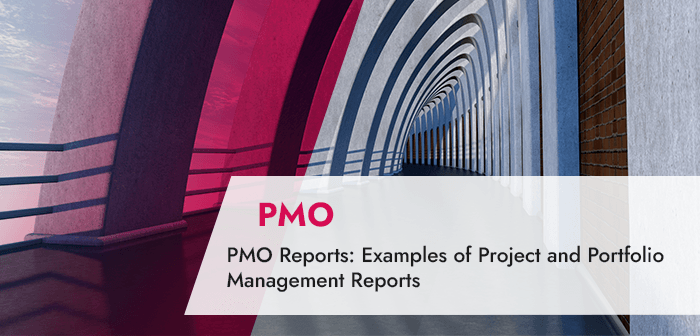
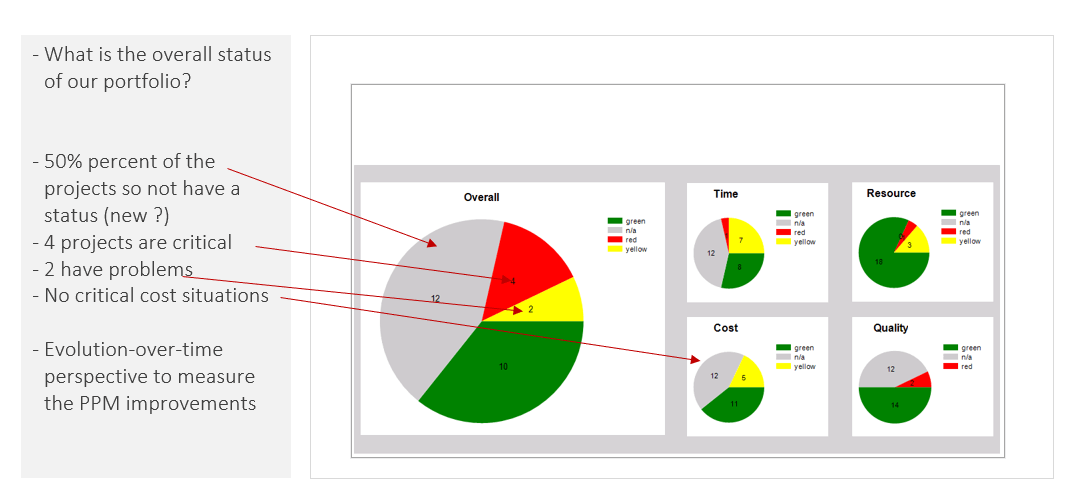
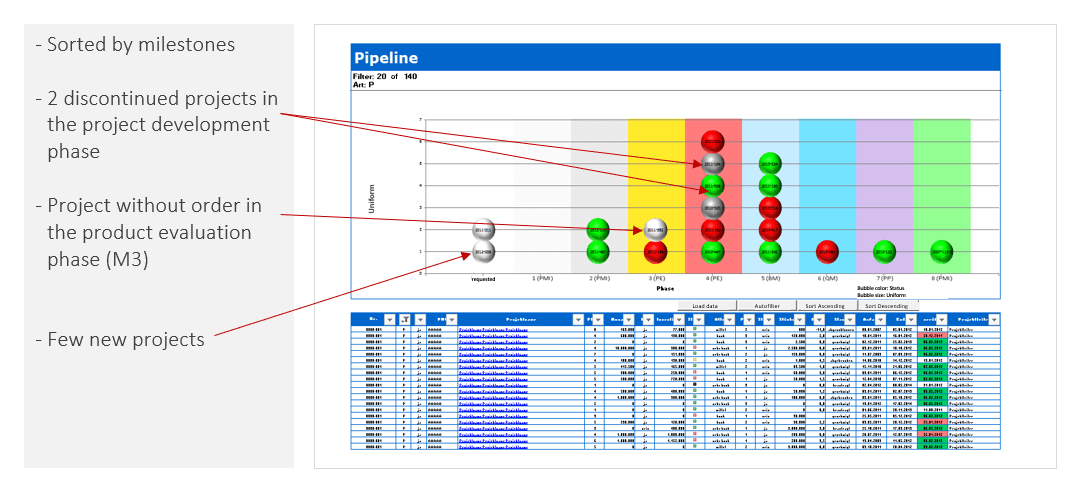
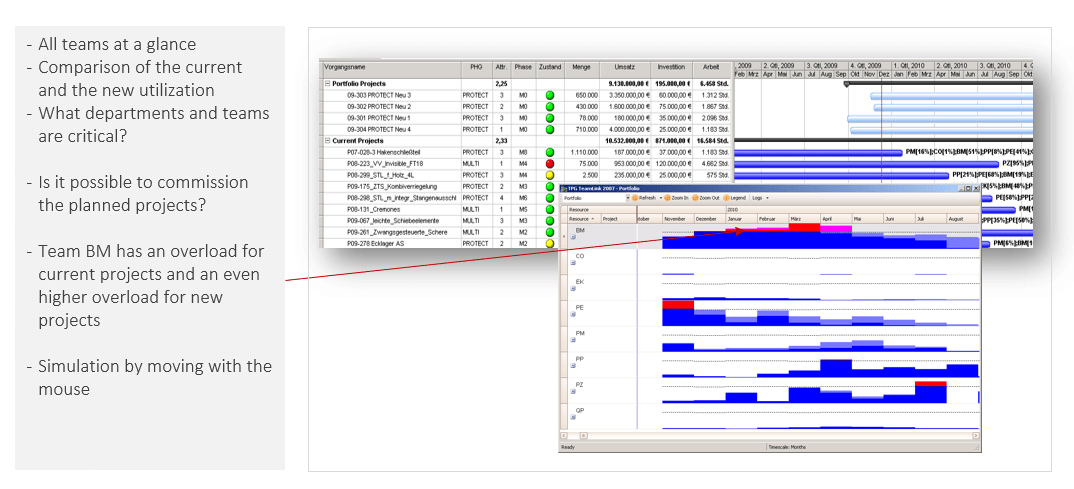
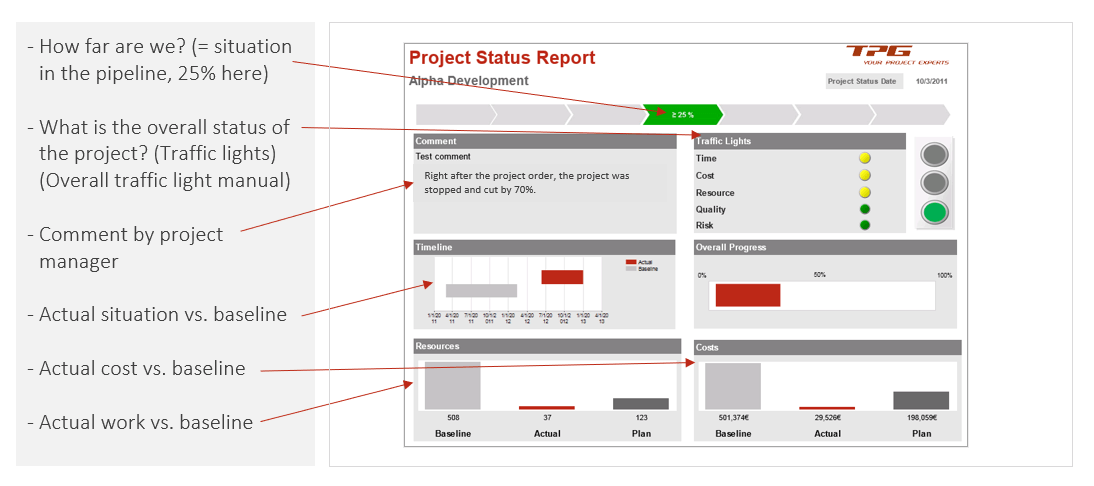
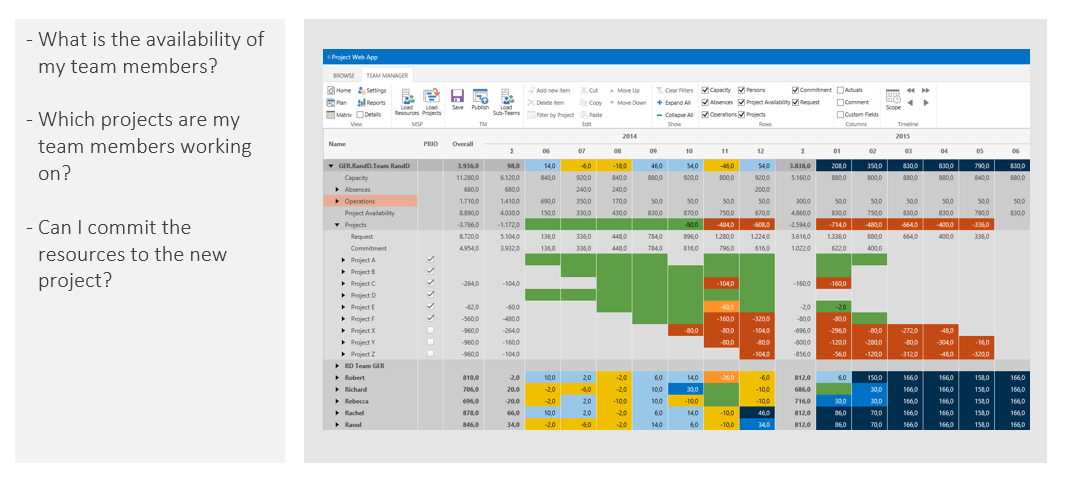
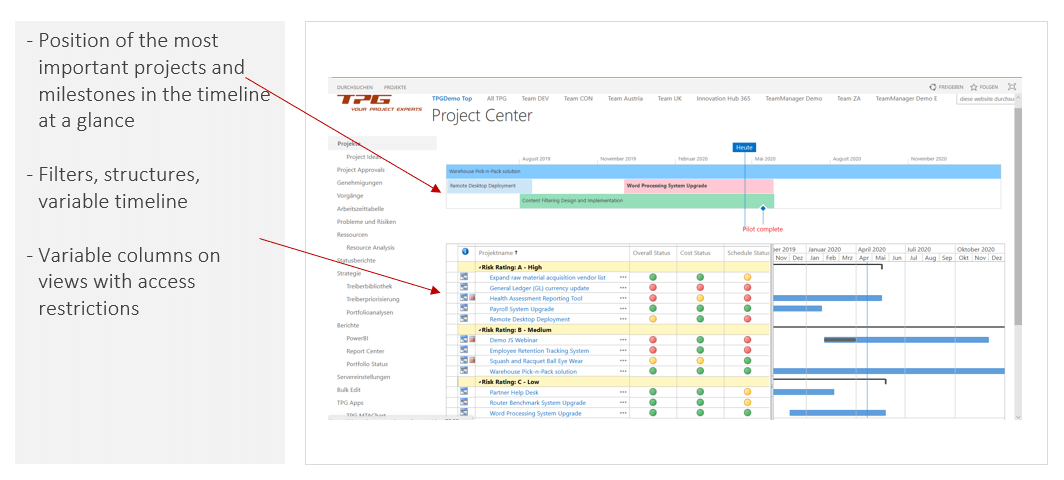
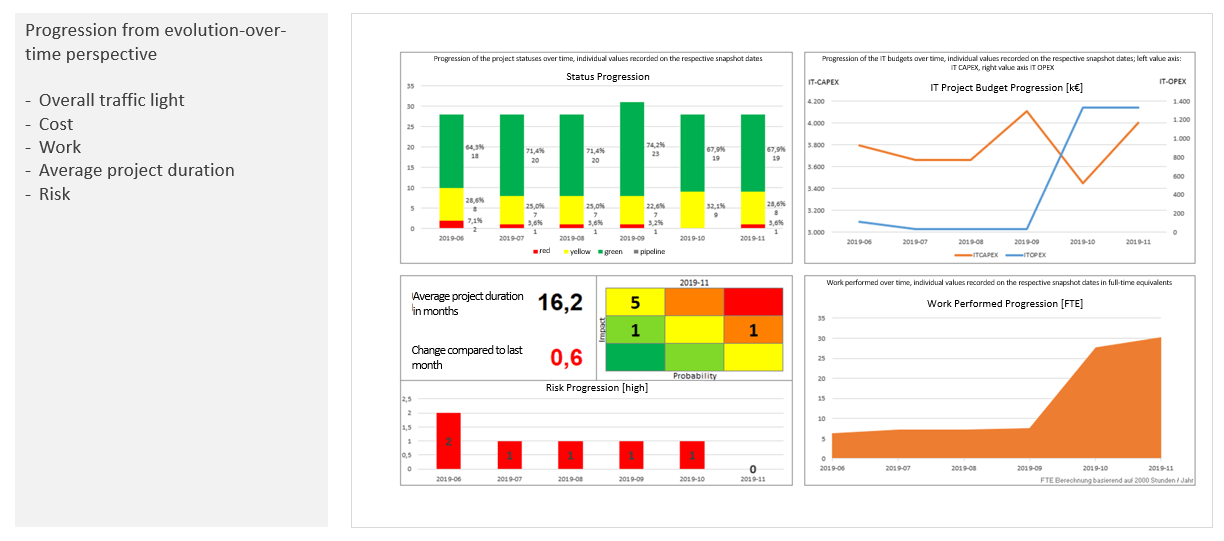
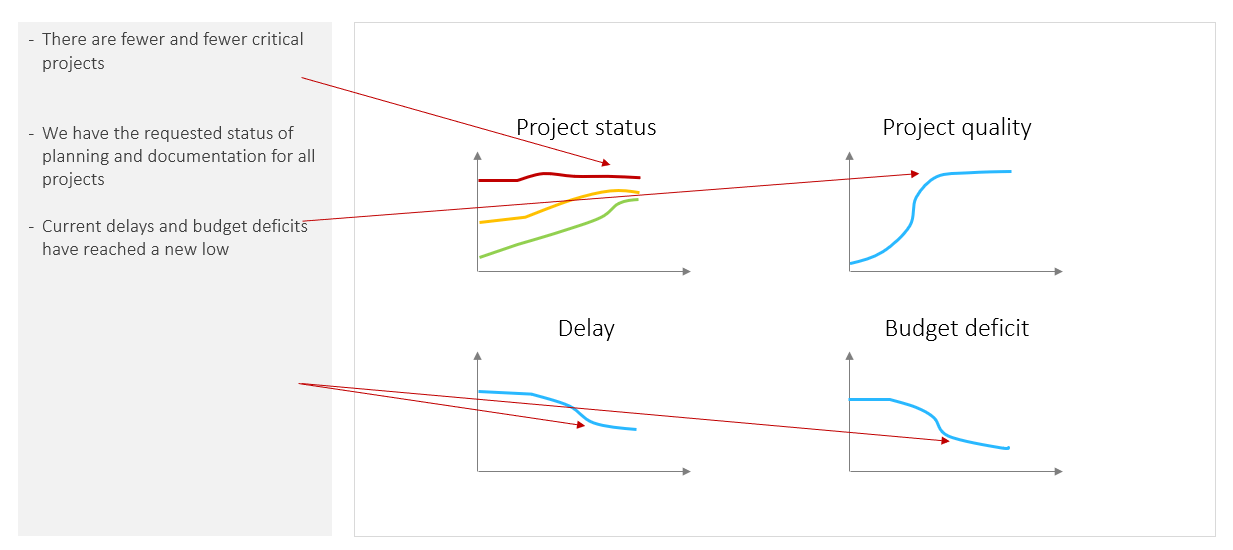
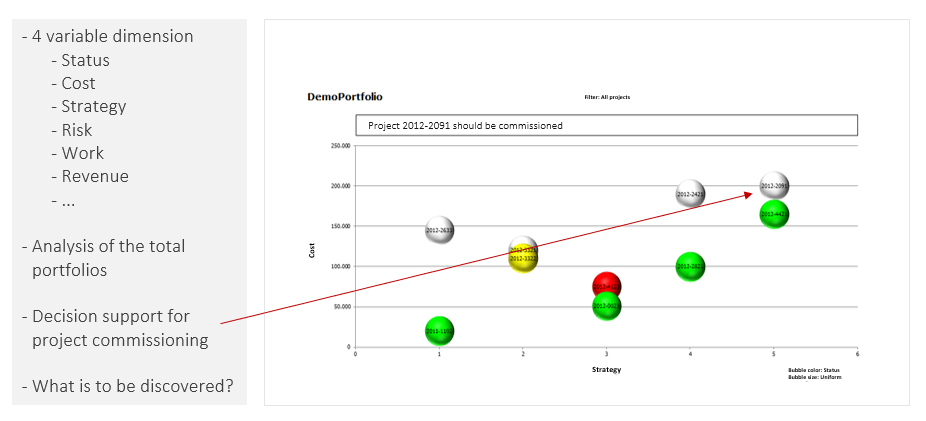
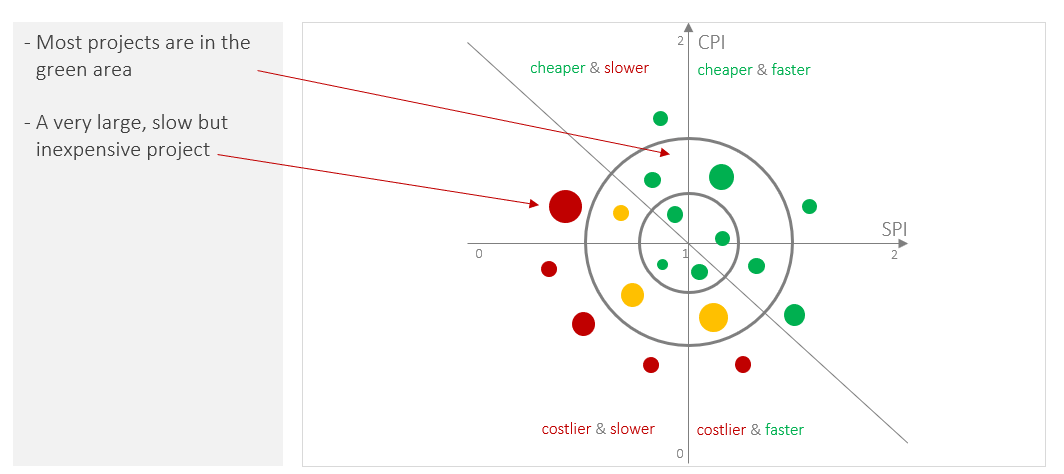

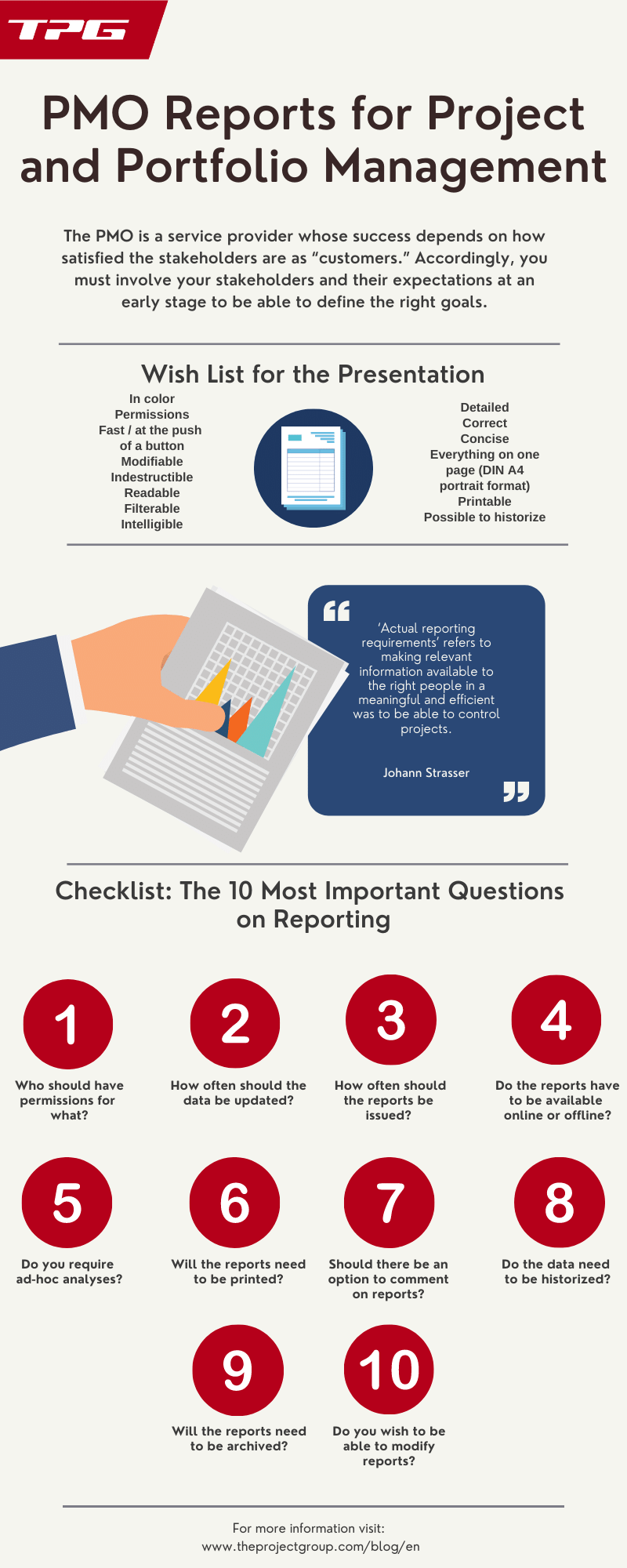


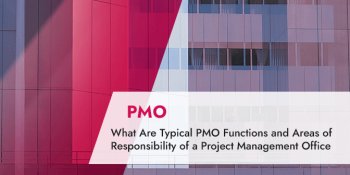

6 Comments
PMO report is very essential if you are preparing a project report of your business. PMO also need that the project report should be accurate and correct.
Thank you, good article, I m at the early stage of implementation of a PMO in our hospital and that article help me 🙂
Thank you, Sebastien Yelnik. We’re glad to hear that!
Thank you. I’m preparing a reporting procedure for EPC PROJECT and i think your article gives me the high guidelines i’ll follow to do it.
Are all these report/dashboard examples created in MS Project? Are these possible in Office365 Project? Are there templates? I apologize for the questions and confusion.
Thanks for the comment, Heather. Most of the examples were assembled in PowerPoint, just to portray the potential contents of the reports. The Example: Project overview as an interactive website presents the Project Center of Microsoft Project Online. Below, you see the Example: Current status of the portfolio (evolution-over-time perspective) which was taken from MS Project Professional. Above the “Project Center” (Example: Team planning and commitment in response to project requests), you can see the interface of our product TPG TeamManager, a resource management solution based on SharePoint.
If you are interested in other project control reports, we offer our own TPG Power BI ReportPack based on Power BI which you can add to an existing MS Project Online / Server environment.